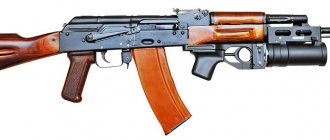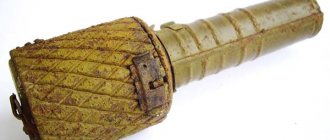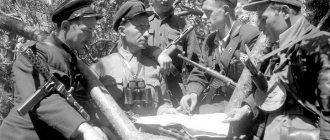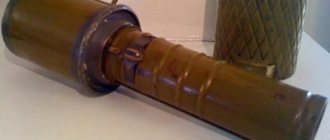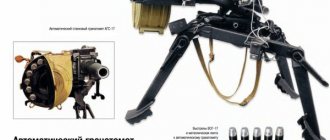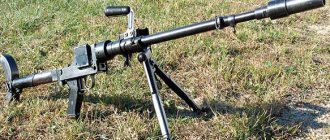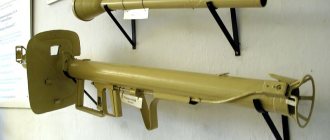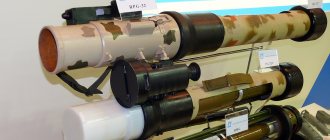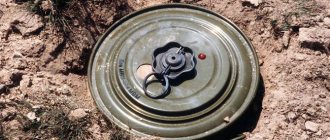RIFLE ANTI-TANK GRENADES
In World War II, almost all armies used rifle (rifle) grenades. It is worth noting that back in 1914. Staff Captain of the Russian Army V.A. Mgebrov proposed using his rifle grenade against armored vehicles - this, by the way, was perhaps the first proposal for an infantry “anti-tank” weapon (although “tanks” themselves did not exist yet), and the British, after the appearance of tanks, recommended their infantry to fire at enemy vehicles with ramrod rifle grenades .
Sectional view of the VKG-40 grenade:
1 – bottom cap; 2 – detonator capsule; 3 – body; 4 – revived; 5- explosive; 6 – settling cylinder (inertial weight); 7 – wire pin; 8 – striker with a sting; 9 – - glass; 10 – washer
Section of the Dyakonov grenade launcher mortar, adapted for firing the VKG-40 grenade. 1 – barrel, 2 – limit screw, 3 – cup, 4 – rifle front sight, 5 – neck
Shavgulidze partisan rifle grenade launcher (PRGSh) and a model grenade for it
In the 20-30s, the Red Army was armed with the muzzle-loading “Dyakonov grenade launcher”, created at the end of the First World War and subsequently modernized. It consisted of a mortar, a bipod and a quadrant sight and was used to destroy manpower with a fragmentation grenade. The mortar barrel had a caliber of 41 mm, three screw grooves, and was rigidly attached to a cup that was screwed onto the neck, which was put on the rifle barrel, fixed on the front sight with a cutout. On the eve of the Great Patriotic War, each rifle and cavalry squad had 8 grenade launchers. Then the question arose about giving the rifle grenade launcher “anti-tank” properties. During the war, the VKG-40 grenade came into service. Its body had a streamlined shape, three leading protrusions on the cylindrical part. A bottom fuse was mounted in the conical tail section, which included an inertial body (“settling cylinder”), a detonator capsule, an additional detonator and a wire pin. The bottom part was closed with a cap. Length of VKG-40 – 144 mm. The grenade was fired with a special blank cartridge containing 2.75 g of VP or P-45 gunpowder. The barrel of the cartridge case was crimped with an “asterisk” and, like the head of the grenade, was painted black. The mortar also changed: a special front sight with a guard was attached to the neck, and a screw screwed into the barrel limited the advance of the grenade during chambering. The reduced charge of the blank cartridge allowed the grenade to be fired at direct fire with the butt resting on the shoulder. Shooting was carried out without a bipod, using a rifle scope: o corresponded to a range of up to 50, “18” – up to 100 and “20” – up to 150 m. The total weight of the rifle with the mortar was 6 kg, such a “grenade launcher” was serviced by one person (unlike for a fragmentation grenade there was no need to expose the tube before loading). The rate of fire reached 5-6 rds/min. The VKG-40 was used very limitedly, which is partly explained by the low accuracy of fire, and partly by the underestimation of the rifle grenade launcher in general. However, later VG-45 and VG-44 anti-tank rifle grenades were adopted for carbines.
At the beginning of 1942, the ramrod VPGS-41 (“Serdyuk’s rifle anti-tank grenade model 1941”), created in the design bureau of the People’s Commissariat of the Coal Industry, headed by Serdyuk, entered service. VPGS-41 consisted of a streamlined body with a shaped charge and a fuse and a “ramrod” tail inserted into the rifle barrel. A clip with an annular stabilizer was put on a cleaning rod equipped with a sealing groove. When the ramrod was inserted into the barrel, the stabilizer was pressed against the body, and after the grenade flew out, it was fixed at the rear end of the ramrod. The shot was fired with a blank cartridge. The firing range is up to 60 m, and against a stationary cluster of equipment – up to 170 m (at an elevation angle of 40 degrees). VPGS played a role during the Battle of Moscow - it was produced, for example, by Moscow and "Red Torch". The accuracy and effective range were low, there were frequent cases of premature detonation of the fuse when fired, in addition, the “ram rods” quickly spoiled the bore of the rifle, and the grenade, initially ordered in large quantities, was already taken out of production and out of service in 1942.
The partisans also had their own grenade launchers - for example, the PRGSh developed a very successful mortar from a 45-mm shell casing, high-explosive fragmentation and anti-tank grenades in 1943. fighter of the Minsk partisan unit T.E. Shavgulidze.
The British 51 mm rifle grenade launcher on the Lee Enfield rifle remained in service long after World War II. In the picture he is in the hands of an Indian Army infantryman. 1970s.
Rifle cumulative grenade No. 68, general view and section: 1 – explosive charge with a cumulative funnel, 2 – detonator cap, 3 – igniter cap. 4 – drummer, 5 – fuse
Vietnamese guerrilla with M9-type finned anti-tank rifle grenades in a bag on a damaged American M113 armored personnel carrier
American M9AI feathered anti-tank rifle grenade
At the end of the First World War, the British Army intended to use the No. 44 high-explosive ramrod rifle grenade with a head impact fuse against the few German tanks. In addition to the ramrod-tail, the grenade had a ring stabilizer, which ensured better accuracy and correct fall than that of similar grenades. There was no evidence of its use against tanks.
During World War II, to combat tanks and armored vehicles, the British used a 51-mm muzzle-loading smoothbore rifle grenade launcher (mortar), originally created to fire a Mils hand grenade. Already in 1940, grenade No. 68 appeared, which had a cylindrical steel body with a shaped charge (covered with a flat lid), an inertial bottom fuse, an igniter cap and a detonator cap.
Armor penetration was about 50 mm. A stabilizer with four blades was screwed into the rear part of the body. The body was painted yellow-brown with red and green stripes. Shot - with a blank cartridge, from a rest position, the fuse pin was removed before the shot. The firing range is up to 91 m (100 yards), but the most effective is 45-75 m. Grenade No. 68 was used to a limited extent in battles in 1940. in France, in 1941-1942. issued mainly in local defense (Home Guard). The grenade could also be fired from a light 51 mm mortar.
During the war, the US Army developed a system of rifle grenades, which included anti-personnel, anti-tank, training and smoke models. There were no mortars - the grenades were equipped with stabilizer tubes. The tube was mounted on a “throwing device” - a special muzzle on the barrel of a carbine or rifle. The grenades were fired with corresponding blank cartridges. The M9A1 anti-tank grenade had a streamlined body with a cumulative combat charge, a stabilizer tube with a ring stabilizer and a bottom inertial fuse. Fan length – 284 mm, case diameter – 51 mm. The initial speed when firing from a carbine is 45 m/s, the firing range is up to 175 m. From a rifle – 55 m/s and up to 250 m. The accuracy of fire, however, made it possible to effectively fire at armored targets at much shorter ranges. American Marines used such grenades, not without success, in 1944 on the Pacific Islands against relatively lightly armored Japanese tanks - fortunately, the terrain and thickets allowed them to shoot at tanks almost point-blank. For training, a training M11-A2 without a charge was used, which replicated the M9A1 in shape, size and weight. Feathered rifle grenades. fired from a small choke tube or flash suppressor. turned out to be a more promising direction for the development of this type of ammunition than mortars. At the beginning of the war, the United States considered the option of a rocket-propelled anti-tank grenade using a rifle bayonet as a guide, but was rejected.
The German Schiessbecher- (“Shooting cup”) grenade launcher was a muzzle-loading 30-mm rifled mortar weighing 0.835 kt The barrel was screwed into a cup that smoothly turned into the neck The mortar was put on the barrel of a rifle or carbine and fastened with a clamping device The sight was fastened with a clip with a screw in front of the receiver on the left Its swinging part had a sighting bar with a front sight and a whole at the ends, a level and a sector rear part with divisions from 0 to 250 m through 50. The weight of the grenade launcher on the Mauser 98k carbine was 5.12 kg. length - 1250 mm The grenades had ready-made rifling, which, when loaded, was combined with the rifling of the mortar. A blank cartridge was sealed with each grenade
German grenade launcher "Schiessbecher" mounted on the barrel of a '98k carbine (above) and a general view of the grenade launcher mortar 1 - the mortar barrel. 2 – calyx. 3 – neck. 4 – carbine front sight. 5 – clamping device. 6 – clamping screw 7 – clamping screw handle. 8 – carbine barrel
German anti-tank grenade launcher C/B-39
Caliber - small armor-piercing grenade - G Pz gr with capping and blank throwing cartridge, grenade in section. I – ballistic cap. 2 – cumulative crater, 3 – combat charge. 4 – body, 5 – additional detonator. 6- detonator capsule. 7 – cardboard tube. 8 – detonator. 9 – paper ring. 10 – bushing. 11 – igniter primer. 12 – stem. 13 – sting, 14 – ribbon spring. 15 – inertial ring, 16 – pin, 17 – striker. 18-bottom.
Section of an over-caliber large armor-piercing grenade Gr G Pz gr I – ballistic cap (tip). 2 – diaphragm. 3 – cumulative funnel 4 – body. 5 – combat charge, 6 – additional detonator (based on a heating element). 7 – paper gasket. 8 – detonator 10 – detonator capsule. 11 – paper gaskets 12 – bushing 13 – igniter primer 14 stem. 15 – band spring 16 – hammer with tip 17 – safety spring. 18 – bottom 19 – washer 20 – rigid fuse. 21 - inertial ring. 22 – support washer
The caliber “small armor-piercing grenade” G Рг.дг had an ogive-cylindrical body and ready-made rifling on the tail. The shaped charge was covered with a ballistic cap and detonated by a bottom inertial fuse through a detonator capsule and an additional detonator. The length of the grenade was 163 mm, the body was black. The grenade was fired from a cartridge with a charge of 1.1 g of gunpowder, a wooden wad and a black ring around the primer. Initial speed – 50 m/s, firing range – 50-125 m.
With the outbreak of the war with the USSR, in order to increase the “armor-piercing” properties of the grenade launcher, the “large armor-piercing” Gr.G.Pz.gr grenade had to be introduced into service. It was an over-caliber grenade with a thickened front part and a long “stem”. The stem had a threaded sleeve at the back (made of plastic or aluminum), which was inserted into the mortar. The bottom inertial fuse was cocked after the shot. Length – 185 mm, diameter – 45 mm, penetration – 40 mm – at an angle of up to 60 degrees, body – black. Shot - with a cartridge with 1.9 g of gunpowder and a black wooden bullet (wad). Initial speed – 50 m/s. With high armor penetration, the grenade had low accuracy, so shooting at moving targets was carried out at a distance of up to 75 m, at stationary targets - up to 100 m. When firing a regular cartridge from a rifle with a mortar, some excess of the sight was taken. Each infantry, tank-fighter and engineer company had 12 mortars, and field batteries had two. Each mortar was equipped with 30 fragmentation grenades and up to 20 “armor-piercing” grenades. However, as in the Red Army, in the Wehrmacht PT rifle grenades were used little, since “the impact of a rifle grenade on the crew and internal equipment of the tank was very insignificant” (E. Middeldorf).
“Kampfpistole Z” based on the “Walter” signal pistol (left) and the Wurfmine H62P grenade (right)
Over-caliber “large armor-piercing grenade model 1943.” Gr.G.Pz.gr.61. A - section of a grenade: 1 - ballistic cap (tip), 2 - cumulative funnel, 3 - body, 4 - combat charge, 5 - stem with ready-made rifling, 6 - detonator shell, 7 - detonator, 8 - detonator capsule, 9 - primer sleeve, 10 - cardboard ring, 11 - cap, 12 - fuse. B – general view and section of the fuse: 1 – bushing, 2 – fuse cover. 3 - pin, 4 - fuse body, 5 - detonator capsule, 6 - bushing tooth, 7 - sting, 8 - inertial ring, 9 - hammer, 10 - counter-safety spring.
Section of a “pistol” anti-tank grenade Panzerwurfkorper 42LP
By the end of 1941 the ineffectiveness of the 7.92 mm Pz.B.-39 anti-tank rifle became clear, and in 1942. on its basis, the Gr.B.-39 (“Granatbuche 39”) anti-tank grenade launcher was created. The barrel was shortened to 595-618 mm, the breech was simplified, the forend was removed, and a 30-mm rifled mortar was installed at the end of the barrel. Its cup was already screwed onto the PTR barrel. Mortar length – 130 mm, weight – 0.8 kg. Sights included front and rear sights on the left side of the weapon. The rear sight - a rear sight with a slot - was mounted on a bracket in a groove in the receiver. The front one was fastened with a clip on the breech of the barrel and consisted of a grid of six horizontal and one vertical threads: the horizontal ones marked distances of up to 150 m every 25, the vertical one formed sighting crosshairs. A casing with a shield with three holes was attached to the sight frame: the middle one served as an auxiliary front sight (range - 75 m) in the dark. Targeting the tanks was carried out along the lower edge of the turret, in the middle, or with a distance of 0.5-1 corps - when the target was moving. Firing at moving targets was carried out at a distance of up to 75 m, at stationary targets - up to 150 m. The weight of the grenade launcher was 10.5 kg, the length in the firing position was 1230 mm, in the stowed position - 908 mm, crew - 2 people. The shooting was carried out by "Gr.G.Pz.gr." with a reinforced stem and “improved rifling” or a special “large armor-piercing grenade model 1943.” Gr.G.Pz.gr.61. The latter was distinguished by a drop-shaped shape, greater strength, a strong charge, and a fuse that was triggered at any angle of contact. Length Gr.G.Pz.gr.61 – 195 mm, case diameter – 46 mm. The grenade had a light brown stem color, was fired only from the Gr.B-39 with a cartridge with a black wooden bullet (the cartridge case was for the Pz.B.-39), the initial speed was 65 m/s. For firing grenade Gr.G.Pz.gr. (Gr.G.Pz.gr.46) a “throwing” cartridge was used based on the “318” cartridge with a reinforced powder charge. Firing “small” or unreinforced “large” grenades was not allowed: they could be destroyed when fired. Like most rifled “rifle mortars,” this grenade launcher had a significant drawback - it was slow to load and insert a grenade from the muzzle, which reduced the practical rate of fire and survivability of the weapon in close combat.
The desire to use any weapon as a weapon led to the creation of grenades for pistols. In Germany, the “Wurfgranatpatron 326 HL/LP” anti-tank shot with the armor penetration of a 50 mm over-caliber grenade was developed specifically for a signal pistol, but this simple and cheap tool has not been widely used due to its extremely low accuracy. A more successful solution seemed to be the use of the rifled signal "Kampfpistole Z" ("zug" - rifling), created back in the late 30s on the basis of the signal smoothbore "Walter" model 1934 and which had 5 rifling in the barrel. Mass - pistol" - 745 g, length - 245 mm with a barrel length of 155 mm It was converted into a grenade launcher by attaching a metal butt and a folding sight. The mass of such a grenade launcher was 1960. The Wurfgranatpatron H62LP AT shot included a modified PWM-1 hand cumulative grenade, but it began to tumble after 30 m of flight. The most successful was the Panzerwurfkorper 42 LP-1942 AT grenade. It consisted of a drop-shaped body with a charge (RDX with TNT) and a bottom inertial fuse and a rod with ready-made rifling at the end. The rod contained an igniter primer, an expelling charge of porous pyroxylin powder and a piston that cut off the connecting pin when fired and ejected the grenade. The length of the grenade is 305 mm. largest diameter – 61 mm. The firing range from the “Z” pistol is 50 m; for firing from a conventional signal pistol, a loose-fitting rifled barrel was used.
Anti-tank finned rifle grenades with a cumulative warhead were actively developed in the first two post-war decades (French M1e 50 and Mle 61. Belgian "Energa", American M-31, Spanish G.L61) However, already in the late 1960s, the growth of armor protection of main battle tanks brought such grenades are among the actual anti-tank weapons, leaving the possibility of their use against light armored vehicles and shelters.
It is no coincidence that in their designations the abbreviation 'AT- (anti-tank) was replaced by "AR" (armour penetrative - "armor-piercing"), and cumulative warheads - cumulative fragmentation Tab.2 HAND AND RIFLE ANTI-TANK GRENADES
| Manual | Rifle | |||||||||||
| Grenade | RPG-40 | RPG-43 | RPG-6 | PWM 1 | N.N.Z | "sticky" | VKG-40 | G P7 gr | Gr.G Pz gr | G.Pz Gr 43 | М9А1 | 42 LP to signal. pist. |
| Grenade type | manual | manual with stabilizer | magnet | sticky | caliber | over-caliber | oper. | overcalib. | ||||
| Charge type | high explosive | cumulative | cumulative | |||||||||
| A country | USSR | Germany | USSR | Germany | USA | Germany | ||||||
| Year of issue | 1940 | 1943 | 1943 | 1943 | — | — | 1940 | 1941 | 1941 | 1943 | — | 1943 |
| Grenade weight, g | 1200 | 1200 | 1130 | 1450 | 3690 | 440 | 220 | 245 | 385 | 390 | 550 | 600 |
| combat charge | 760 | 650 | 600 | 525 | 930 | 180 | 90 | 54 | 120 | 145 | 113 | 185 |
| Armor test, mm | 20 | 75 | 100 | 150 | 150 | 45 | 50 | 25 | 40 | 60 | approx.50 | 80 |
| Throw (firing) range, m | 20-25 | 15-20 | 15-20 | 20-25 | — | up to 15 | up to 50 | up to 125 | 75-100 | 75-100 | 175-250 | 50 |
Table of contents
Mortar
19. The mortar (Fig. 16) serves to direct the flight of the grenade. It is mounted on the muzzle of the rifle and consists of a barrel, a connecting cup and a neck.
The barrel directs the flight of the grenade. Inside it has 3 screw grooves, which give the grenade a rotational movement for stability during flight. The barrel is tightly screwed into the connecting cup.
Rice. 16. Mortar:
1 - cranked slot, 2 - neck, 3 - connecting cup, 4 - barrel, 5 - rifling, 6 - barrel bore, 7 - neck bore
The connecting cup serves to fasten the barrel to the neck; at the ends inside it has a screw thread.
The neck serves to strengthen the mortar on the rifle. It has an elbow slot for the passage of the base of the front sight (mushnik) into a screw thread for screwing into the connecting cup when attaching the mortar to the rifle.
Protractor-quadrant (sample 1937)
20. The quadrant protractor (Fig. 17) is used for aiming the grenade launcher. It is mounted on the rifle in the recesses of the stock and consists of a protractor, a quadrant and a clamp.
The goniometer is used for horizontal aiming of the grenade launcher. It is mounted on an axle on the right side of the clamp and can rotate on the axle and be held in the position given to it. There is a scale on the protractor. One small scale division is equal to 20 thousandths. Every five small divisions (100 thousandths) to the right and left of zero are indicated by a large line; every two major divisions are numbered sequentially with the numbers 2 and 4 (200 and 400 thousandths).
Rice. 17. Protractor-quadrant (sample 1937):
1 - quadrant, 2 - quadrant window, 3 - scale of elevation and declination angles, 4 - support plates, 5 - clamping screw with wing,
6 — goniometric scale, 7 — window with pointer, 8 — slot, 9 — sighting line, 10 — front sight, 11 — folding part of the clamp
In the front part of the protractor, on the axis there is a sighting ruler with a slot and a front sight for sighting. To set the ruler to the desired scale division, there is a window with a pointer at its rear end. When you set the pointer to the zero division of the protractor scale, the ruler becomes parallel to the mortar axis.
The quadrant serves to give the grenade launcher elevation and declination angles during vertical aiming. It is tightly fixed on the left side of the clamp and consists of a box, a pendulum with a scale of elevation and declination angles.
The box has a window on which there is a setting line for setting the quadrant scale divisions along it.
The pendulum is mounted on an axis inside the box. There is a weight at the end of the pendulum to hold it in place.
The quadrant scale is mounted on a pendulum. Its divisions are marked in degrees. Each small division is equal to 2 degrees (in the quadrants of old samples - 5 degrees). The lower part of the scale with numbers from 0 to 45 serves to indicate the elevation angles of the grenade launcher; the top one - with numbers from 0 to 15 - to give declination angles.
When the grenade launcher is aimed vertically, the pendulum with a scale, held by a weight, remains in place, while the quadrant box rotates around the scale; in this case, the setting line of the box window moves along the quadrant scale and shows the elevation (declination) angle assigned to the grenade launcher.
When the grenade launcher is in a horizontal position, the setting line is opposite the zero division of the scale.
The clamp serves to strengthen the quadrant protractor on the rifle. It has two support plates that fit into recesses in the stock and are held against the rifle by a wing screw; the right half of the clamp is folding.

